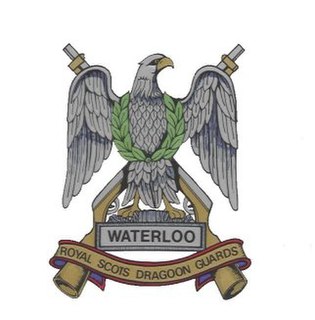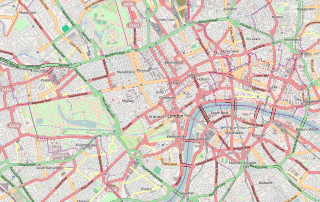
The Coldstream Guards is a part of the Guards Division, Foot Guards regiments of the British Army.

The Royal Scots Dragoon Guards is a cavalry regiment of the British Army, and the senior Scottish regiment. The regiment, through the Royal Scots Greys, is the oldest surviving Cavalry Regiment of the Line in the British Army. The regiment is currently based at Leuchars Station, as part of the Scottish 51st Infantry Brigade.

The Welsh Guards, part of the Guards Division, is one of the Foot Guards regiments of the British Army. It was founded in 1915 by Royal Warrant of George V.
The Household Cavalry (HCav) is made up of the two most senior regiments of the British Army, the Life Guards and the Blues and Royals. These regiments are divided between the Armoured Regiment stationed at Combermere Barracks in Windsor and the ceremonial mounted unit, the Household Cavalry Mounted Regiment, garrisoned at Hyde Park Barracks in London. The Household Cavalry is part of the Household Division and is the Queen's official bodyguard.

The Lancashire Infantry Museum, formerly known as the Queen's Lancashire Regiment Museum, is located at Fulwood Barracks in Preston, Lancashire, England. The museum claims to be "largest Regimental archive and the premier centre for military historical research in the North of England."

The Governor General's Foot Guards (GGFG) is one of three Royal Household regiments in the Primary Reserve of the Canadian Army and the most senior militia infantry regiment in Canada. Civitas et Princeps Cura Nostra is the regiment's motto.

The Queen's Guard and Queen's Life Guard are the names given to contingents of infantry and cavalry soldiers charged with guarding the official royal residences in the United Kingdom. The British Army has regiments of both Horse Guards and Foot Guards predating the English Restoration (1660), and since the reign of King Charles II these regiments have been responsible for guarding the Sovereign's palaces. Despite tourist perceptions, the Guards are not purely ceremonial and are fully operational soldiers.

The French Imperial Eagle refers to the figure of an eagle on a staff carried into battle as a standard by the Grande Armée of Napoléon I during the Napoleonic Wars.

The Royal Dragoon Guards (RDG) is a cavalry regiment of the British Army. It was formed in 1992 by the amalgamation of two other regiments: The 4th/7th Royal Dragoon Guards and the 5th Royal Inniskilling Dragoon Guards. The regiment currently serves as the Armoured Cavalry Reconnaissance unit of the 20th Armoured Infantry Brigade and is therefore equipped with the Combat Vehicle Reconnaissance (Tracked) Scimitar and is based in Catterick Garrison, North Yorkshire. Today the RDG is an operationally experienced regiment having recently served in Iraq, and Afghanistan.

The 3rd Carabiniers was a cavalry regiment of the British Army. It was formed in 1922 as part of a reduction in the army's cavalry by the amalgamation of the 3rd Dragoon Guards and the Carabiniers, to form the 3rd/6th Dragoon Guards. It was renamed the 3rd Carabiniers in 1928 and amalgamated with the Royal Scots Greys, forming the Royal Scots Dragoon Guards in 1971.

The Japanese Imperial Guard is the name of two separate organizations dedicated to the protection of the Emperor of Japan and the Imperial House of Japan, palaces and other imperial properties. The first was a quasi-independent branch of the Imperial Japanese Army which was dissolved at the end of World War II. The second is the Imperial Guard Headquarters, a civilian Imperial Guard formed as part of the National Police Agency of Japan.

The Pennsylvania Army National Guard, abbreviated PAARNG, is part of the United States Army National Guard and is based in the U.S. Commonwealth of Pennsylvania. Together with the Pennsylvania Air National Guard, it is directed by the Pennsylvania Department of Military and Veterans Affairs. The PAARNG maintains 124 armories and is present in 87 communities across the Commonwealth.
The 100th Guards Rifle Division was an elite Red Army airborne infantry division during World War II. The division fought in the Vyborg–Petrozavodsk Offensive and the Vienna Offensive. Postwar, it was designated as an airborne division and disbanded in 1955.

The 2nd Dragoon Guards was a cavalry regiment of the British Army. It was first raised in 1685 by the Earl of Peterborough as the Earl of Peterborough's Regiment of Horse by merging four existing troops of horse.

The 3rd Dragoon Guards was a cavalry regiment in the British Army, first raised in 1685 as the Earl of Plymouth's Regiment of Horse. It was renamed as the 3rd Regiment of Dragoon Guards in 1751 and the 3rd Dragoon Guards in 1765. It saw service for two centuries, including the First World War, before being amalgamated into the 3rd/6th Dragoon Guards in 1922.
In countries whose armies are organised on a regimental basis, such as the army of the United Kingdom, a regimental museum is a military museum dedicated to the history of a specific army regiment.

Firing Line: Cardiff Castle Museum of the Welsh Soldier is a museum which exhibits the collections of the 1st The Queen's Dragoon Guards and the Royal Welsh. It occupies the lower floor of the interpretation centre at Cardiff Castle.

The Queen's Guards is a 1961 military drama film directed by Michael Powell from a script by Simon Harcourt-Smith and Roger Milner. It stars Daniel Massey, Raymond Massey, Robert Stephens, and Ursula Jeans.
The Grenadier Guards is an infantry regiment of the British Army. It is the most senior regiment of the Guards Division and, as such, is the most senior regiment of infantry. It is not, however, the most senior regiment of the Army, this position being held by the Life Guards. Although the Coldstream Guards were formed before the Grenadier Guards, the regiment is ranked after the Grenadiers in seniority as, having been a regiment of the New Model Army, the Coldstream Guards served the Crown for four fewer years than the Grenadiers.
The 251st Coast Artillery was a coast artillery regiment in the California National Guard, constituted in 1924 as a harbor defense regiment and redesignated in 1930 as an antiaircraft regiment. It served in World War II in that capacity.



















